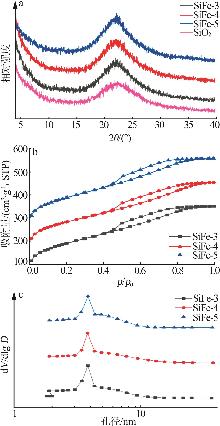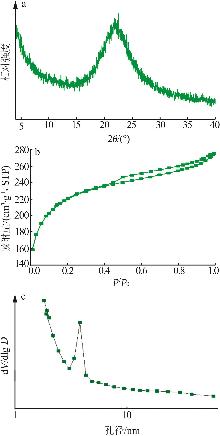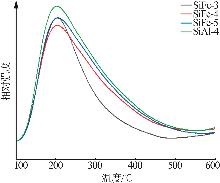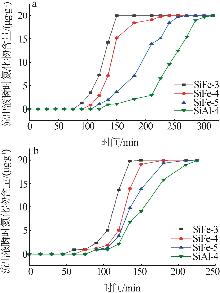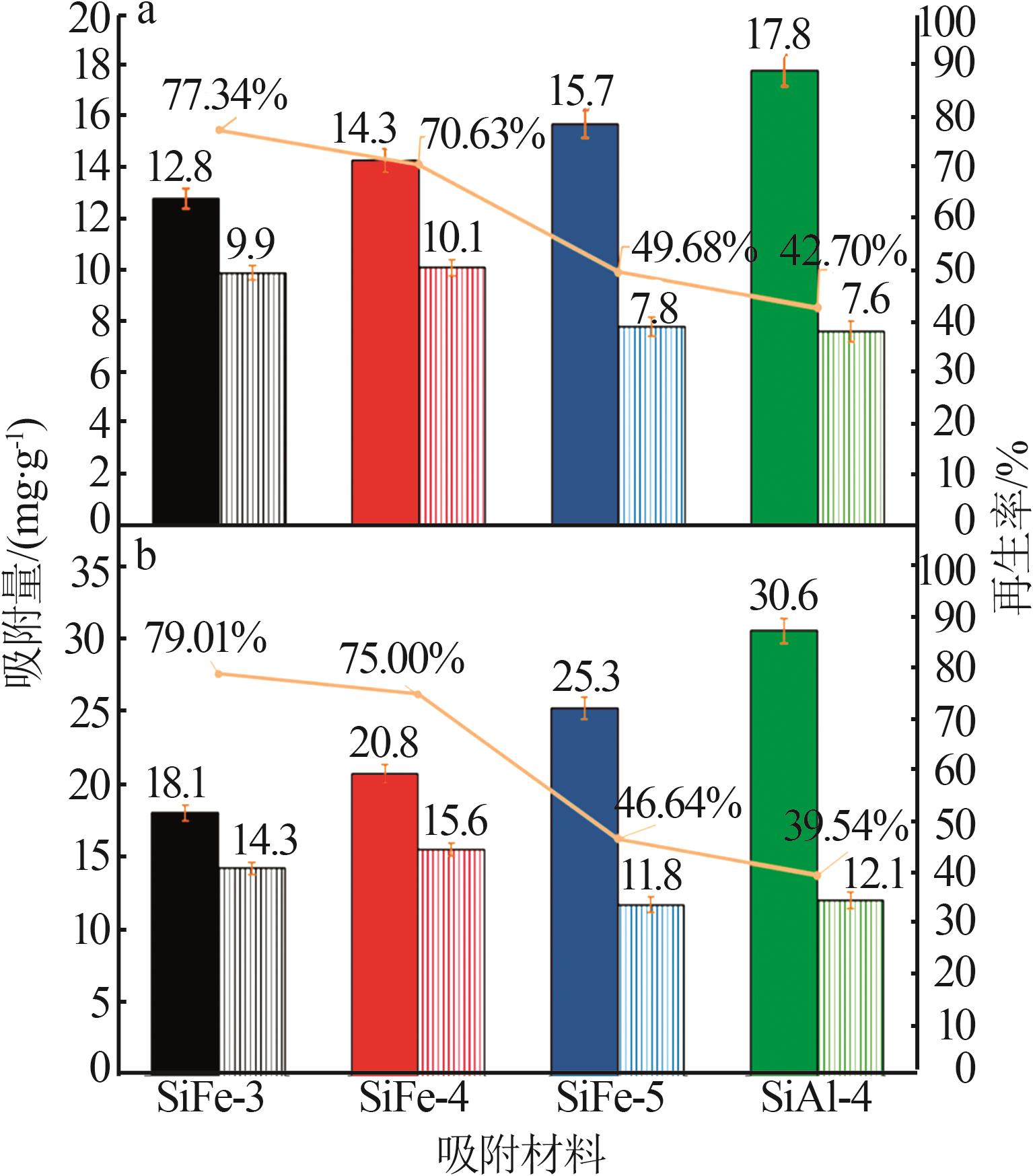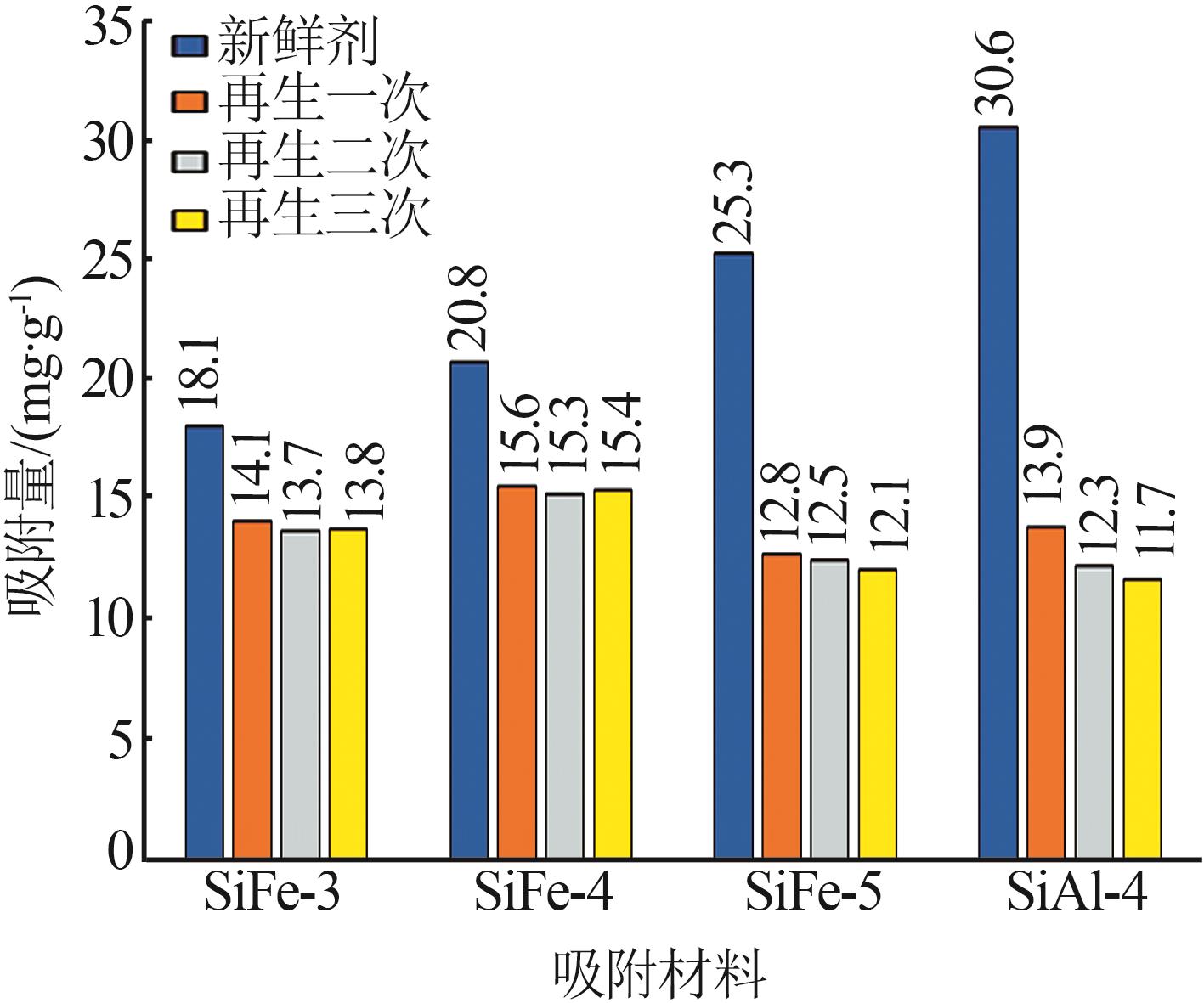Inorganic Chemicals Industry ›› 2025, Vol. 57 ›› Issue (6): 49-55.doi: 10.19964/j.issn.1006-4990.2024-0533
• Research & Development • Previous Articles Next Articles
Study on adsorption and denitrification performance of iron doped modified SiO2
PANG Hao( ), LI Bin, SUN Zhenhai, GUO Jian, CAI Zhe, WU Luming, HONG Meihua, YANG Zhanfeng
), LI Bin, SUN Zhenhai, GUO Jian, CAI Zhe, WU Luming, HONG Meihua, YANG Zhanfeng
- CNOOC Tianjin Chemical Research and Design Institute Co. ,Ltd. ,Tianjin 300131,China
-
Received:2024-10-09Online:2025-06-10Published:2025-06-25
CLC Number:
Cite this article
PANG Hao, LI Bin, SUN Zhenhai, GUO Jian, CAI Zhe, WU Luming, HONG Meihua, YANG Zhanfeng. Study on adsorption and denitrification performance of iron doped modified SiO2[J]. Inorganic Chemicals Industry, 2025, 57(6): 49-55.
share this article
Table 1
Element compositions and pore structure data of prepared adsorbent materials"
样品 名称 | 元素组成a/% | 孔结构 | 总酸 量/(mmol·g-1) | |||||||
|---|---|---|---|---|---|---|---|---|---|---|
| w(SiO2) | w(Fe2O3) | w(Al2O3) | w(杂质) | SBETb/(m2·g-1) | VTotal/(cm3·g-1) | D/nm | ||||
| SiFe-3 | 96.75 | 2.98 | 0 | 0.27 | 625 | 0.55 | 3.5 | 0.498 | ||
| SiFe-4 | 95.71 | 4.03 | 0 | 0.26 | 652 | 0.56 | 3.4 | 0.577 | ||
| SiFe-5 | 94.77 | 4.97 | 0 | 0.26 | 651 | 0.54 | 3.3 | 0.616 | ||
| SiAl-4 | 95.75 | 0 | 3.98 | 0.27 | 699 | 0.43 | 2.4 | 0.653 | ||
| 1 | 王鹏岳,欧少源,周生学.燃油脱氮技术研究进展[J].山东化工,2024,53(18):73-77. |
| WANG Pengyue, Shaoyuan OU, ZHOU Shengxue.Research progress of fuel oil denitrogen technology[J].Shandong Chemical Industry,2024,53(18):73-77. | |
| 2 | 唐津莲,袁起民,李泽坤,等.页岩油反应吸附脱除含氮化合物的研究[J].石油学报(石油加工),2025,41(2):425-432. |
| TANG Jinlian, YUAN Qimin, LI Zekun,et al.Study on removal of nitrogen compounds by reactive adsorption of shale oil[J].Acta Petrolei Sinica(Petroleum Processing Section),2025,41(2):425- 432. | |
| 3 | 秦悦,唐克,王涵,等.MOFs材料MIL-101(Cr)的制备及其吸附脱氮性能研究[J/OL].燃料化学学报(中英文),2024:1-11.(2024-12-17). |
| QIN Yue, TANG Ke, WANG Han,et al.Preparation of MOFs material MIL-101(Cr) and its adsorption and denitrification performance[J/OL].Journal of Fuel Chemistry and Technology,2024:1-11.(2024-12-17). | |
| 4 | 张鹏飞,赵广乐,赵阳,等.劣质蜡油中氮化物的分布、结构及其加氢转化规律分析[J].化工进展,2024:1-12.Doi:10.16085/j.issn.1000-6613.2024-0857 . |
| ZHANG Pengfei, ZHAO Guangle, ZHAO Yang,et al.Distribution and molecular structure of nitrogen compounds in inferior gas oil,and their transformation rules during the hydrotreating process[J].Chemical Industry and Engineering Progress,2024:1-12.Doi:10.16085/j.issn.1000-6613.2024-0857 . | |
| 5 | 丁思佳,蒋淑娇,杨占林,等.基于氮化物结构与加氢行为关系设计重油加氢脱氮催化剂[J].化工进展,2024,43(5):2436-2448. |
| DING Sijia, JIANG Shujiao, YANG Zhanlin,et al.Design of heavy oil hydrodenitrogenation catalysts based on hydrogenation performance determined by structure of nitrogen compounds[J].Chemical Industry and Engineering Progress,2024,43(5):2436-2448. | |
| 6 | 黄镇,鞠雪艳,丁石,等.柴油加氢脱氮集总动力学模型及应用[J].石油学报(石油加工),2024,40(1):175-182. |
| HUANG Zhen, JU Xueyan, DING Shi,et al.Lumped kinetic model and application of diesel hydrodenitrogenation[J].Acta Petrolei Sinica(Petroleum Processing Section),2024,40(1):175-182. | |
| 7 | 房欣,孙潇镝,唐克,等.杂原子Ga[Al]Y分子筛吸附脱氮的模拟计算研究[J].唐山师范学院学报,2024,46(3):23-26,38. |
| FANG Xin, SUN Xiaodi, TANG Ke,et al.Theoretical calculation of nitrogen removal by adsorption of heteroatom Ga[Al] Y molecular sieve[J].Journal of Tangshan Normal University,2024,46(3):23-26,38. | |
| 8 | 孙嘉琪,唐克,赵浩博,等.3种A型分子筛吸附脱除模拟柴油中的喹啉[J].精细石油化工,2024,41(3):1-4. |
| SUN Jiaqi, TANG Ke, ZHAO Haobo,et al.Study on the adsorption removal of quinoline from simulated fuel by three A-type molecular sieves[J].Speciality Petrochemicals,2024,41(3):1-4. | |
| 9 | 段宁,吴依远,张银凤.硅藻土/沸石复合颗粒吸附材料脱氮除磷的吸附动力学及热力学分析[J].硅酸盐通报,2014,33(12):3151-3158. |
| DUAN Ning, WU Yiyuan, ZHANG Yinfeng.Adsorption kinetics and thermodynamics of diatomite/zeolite composite adsorbent nitrogen and phosphorus removal[J].Bulletin of the Chinese Ceramic Society,2014,33(12):3151-3158. | |
| 10 | 洪新,李云赫,袁加成,等.变色硅胶吸附脱除模拟柴油中各种碱性氮化物[J].燃料化学学报,2018,46(3):298-304. |
| HONG Xin, LI Yunhe, YUAN Jiacheng,et al.Various basic nitrogen compounds removal from model diesel by adsorption with allochroic silica gel[J].Journal of Fuel Chemistry and Technology,2018,46(3):298-304. | |
| 11 | 矫宝庆,唐克,洪新,等.活性氧化铝吸附脱除模拟油中吡啶的研究[J].石油炼制与化工,2022,53(3):91-98. |
| JIAO Baoqing, TANG Ke, HONG Xin,et al.Study on adsorption removal of pyridine from model fuels by three kinds of activated alumina[J].Petroleum Processing and Petrochemicals,2022,53(3):91-98. | |
| 12 | GHALOUM N, SAFA M A, BOURESLI R,et al.Liquid-phase adsorption of nitrogen compounds from model diesel fuel on activated carbons[J].Petroleum Science and Technology,2025,43(4):451-470. |
| 13 | DONG Zhijun, HU Zhen, YU Hailian.Adsorptive denitrogenation of diesel by magnetic SiO2@NiFe2O4 [J].Petroleum Science and Technology,2017,35(12):1290-1295. |
| 14 | TANG Ke, HONG Xin.Preparation and characterization of Co-MCM-41 and its adsorption removing basic nitrogen compounds from fluidized catalytic cracking diesel oil[J].Energy & Fuels,2016,30(6):4619-4624. |
| 15 | 中国石油化工股份有限公司科技开发部.石油产品行业标准汇编:2005[M].北京:中国石化出版社,2005:402-405. |
| 16 | 王健捷,束小龙,肖霞,等.多级孔花状ZSM-5分子筛的合成及其正辛烷催化裂解反应性能研究[J].无机盐工业,2024,56(8):139-146. |
| WANG Jianjie, SHU Xiaolong, XIAO Xia,et al.Study on synthesis of hierarchical flower-like ZSM-5 zeolite and its catalytic performance for n-octane cracking[J].Inorganic Chemicals Industry,2024,56(8):139-146. | |
| 17 | DAS J, BHAT Y S, HALGERI A B.Fe-MFI zeolite catalyzed C3 alkylation of benzene[J].Catalysis Letters,1995,32(3):319- 325. |
| 18 | 武鲁明,于海斌,臧甲忠,等.多级孔硅铝酸盐纳米球的合成及其吸附分离多环芳烃[J].化工进展,2023,42(12):6452-6460. |
| WU Luming, YU Haibin, ZANG Jiazhong,et al.Synthesis of hierarchically porous aluminosilicate nanospheres and their adsorption and separation of polycyclic aromatic hydrocarbons[J].Che-mical Industry and Engineering Progress,2023,42(12):6452-6460. | |
| 19 | 唐克,高畅,潘政华,等.硅胶负载杂多酸吸附脱除模拟柴油中的苯胺及其动力学研究[J].精细石油化工,2019,36(2):49-55. |
| TANG Ke, GAO Chang, PAN Zhenghua,et al.Adsorption removal and dynamics of aniline from model diesel with silica gel-supported heteropoly acid[J].Speciality Petrochemicals,2019,36(2):49-55. | |
| 20 | 李云赫,洪新,高畅,等.杂原子介孔MCM-41分子筛的制备及其对含喹啉模拟柴油的吸附脱氮性能[J].燃料化学学报,2019,47(10):1195-1204. |
| LI Yunhe, HONG Xin, GAO Chang,et al.Preparation of heteroatom-containing mesoporous MCM-41 molecular sieves and their performance in the adsorption denitrification of quinoline in model diesel oil[J].Journal of Fuel Chemistry and Technology,2019,47(10):1195-1204. | |
| 21 | 耿嘉悦,于庆雪,赵荣,等.Cr3+、Ni2+改性NaY分子筛的吸附脱氮性能研究[J].江西化工,2021,37(1):43-45. |
| GENG Jiayue, YU Qingxue, ZHAO Rong,et al.Study on adsorption denitrification of NaY molecular sieve modified by Cr3+,Ni2+ [J].Jiangxi Chemical Industry,2021,37(1):43-45. |
| [1] | ZHANG Hanfei, SHEN Hongyan, LIU Youzhi. Study on preparation of MG composite material and its adsorption properties for methyl orange [J]. Inorganic Chemicals Industry, 2025, 57(6): 100-107. |
| [2] | SUN Mengyuan, HE Wei, WANG Chen. Research progress of preparation and adsorption of magnesium oxide fibers and their composite fibers [J]. Inorganic Chemicals Industry, 2025, 57(5): 1-10. |
| [3] | MA Mingyang, CHEN Minyi, SUN Tao, XUE Bin. Study on preparation and oil/water separation performance of silica-mediated superhydrophobic/superoleophilic hybrid sponge [J]. Inorganic Chemicals Industry, 2025, 57(3): 64-70. |
| [4] | BAI Xingxing, LI Hanfei, TANG Yong, ZHANG Jun, ZHU Guangkai, LI Lishuo, TONG Zhangfa. Study on preparation of cellulose based hydrogel doped with nano-calcium carbonate and its adsorption properties of copper ions [J]. Inorganic Chemicals Industry, 2025, 57(2): 83-91. |
| [5] | SHEN Xiaoqian, ZHOU Fei, LIU Wanchen, XU Lu, WU Junshu. Study on synthesis of FeS modified calcium silicate hydrate composites and their total Cr removal performance [J]. Inorganic Chemicals Industry, 2025, 57(2): 57-67. |
| [6] | ZHU Jicheng, YANG Qixin, LIANG Haoquan, WANG Zengkun, OUYANG Fugui, DI Jing, GAI Xikun. Effect of confined catalyst Ni@S2 on performance of methane dry reforming reaction [J]. Inorganic Chemicals Industry, 2025, 57(2): 138-146. |
| [7] | WANG Ping, XU Rongsheng, SUN Dong, SHI Xiaohong, XU Wei, LI Mei. Study on preparation of nitrogen-doped biochar and its adsorption properties for methylene blue [J]. Inorganic Chemicals Industry, 2024, 56(9): 117-127. |
| [8] | SONG Zhaoxia, LIU Yongkang, GUO Yaokun, WANG Tengfei. Study on adsorption performance of wheat straw biochar on malachite green [J]. Inorganic Chemicals Industry, 2024, 56(9): 128-135. |
| [9] | LI Shuai, LI Tianxiang, ZHU Jing, LIU Songlin. Study on purification process of sodium fluoride [J]. Inorganic Chemicals Industry, 2024, 56(9): 90-97. |
| [10] | XIONG Chengrong, CHEN Yan, TANG Miao, ZHANG Fengze, ZHOU Tianxiang, OUYANG Ruifeng, DONG Gang, SHI Wei, ZENG Tao, CHEN Yunxia, SU Xiaoli. Research progress on preparation of 2D vermiculite nanosheets and their environmental adsorption of pollutants [J]. Inorganic Chemicals Industry, 2024, 56(8): 19-26. |
| [11] | ZHANG Bangcheng, WANG Li. Preparation and adsorption properties of waste polyester⁃based activated carbon activated by ZnCl2 [J]. Inorganic Chemicals Industry, 2024, 56(7): 126-134. |
| [12] | ZHANG Lijin, LÜ Qing, CHEN Xiaolang, LI Qingxin, SHI Hongyu, QIN Jun. Preparation of Ca-based LDO composite material and its adsorption performance for phosphate [J]. Inorganic Chemicals Industry, 2024, 56(7): 37-45. |
| [13] | ZHAO Chuang, ZHANG Boyu, LI Ben, JIN Fengying, LI Bin, SUN Zhenhai, GUO Chunlei. Study on adsorption and separation technology of polycyclic aromatic hydrocarbons by adsorbent [J]. Inorganic Chemicals Industry, 2024, 56(7): 61-68. |
| [14] | LIU Kailong, ZHU Kongyi, GUO Chunlei, MA Xiaobiao, WANG Yujian, SHENG Qiang, LI Xiang, WANG Yinbin, JIN Fengying. Effects of process condition on performance of diesel aromatic to light aromatic [J]. Inorganic Chemicals Industry, 2024, 56(6): 139-146. |
| [15] | LEI Xinyu, SUN Henghui, YUAN Xinqiang, ZHANG Wei, JIANG Peng, ZHANG Lizhai. Study on preparation of core-shell structure VO2(M)@SiO2 by silica sol-gel coating [J]. Inorganic Chemicals Industry, 2024, 56(6): 46-54. |
| Viewed | ||||||
|
Full text |
|
|||||
|
Abstract |
|
|||||
|
||
